Tesla Semi: The heavy duty trucking revolution
The convenience of online shopping on Amazon and the having tropical fruits in European supermarkets result from an intricate global supply chain system.
A system that relies on cargo ships, freight trucks and cargo trains to constantly churn goods from all corners of the globe.
Most people don’t understand that there is a significant environmental price to pay for such a system, much of it coming from its carbon emissions which need urgent reduction to reach net zero by 2050.
This being said, there is a new generation of electric heavy-duty semi trucks aiming to decarbonise long-distance freight transport by road, and one particular model is sending ripples of change across the industry.
We present the Tesla Semi: An EV truck that appears to be radically superior to its direct competitors.
Contents
- Does Trucking need disruption?
- A brief history of Electric Trucks
- The Tesla Semi
- Range
- Efficiency
- Charging stations
- Cabin and driving experience
- First orders
- A bright future despite challenges
- Resources
Does Trucking need disruption?
24% of all global greenhouse gas emissions come from transportation, and nearly 30% of this comes directly from road freight transportation (i.e. the delivery of goods on trucks and lorries).
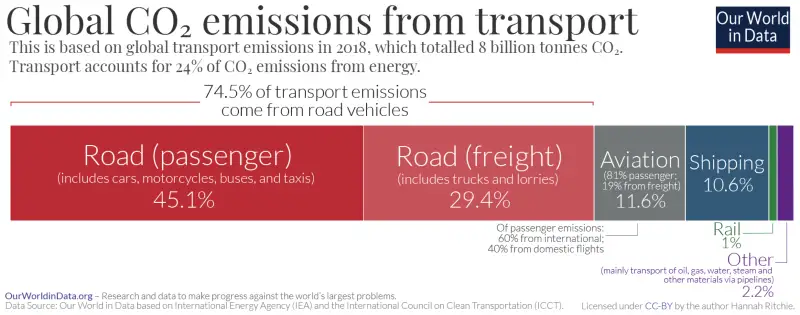
And freight payloads keep increasing year-on-year as global supply chains expand and the global availability of deliverable goods grows together with the expansion of companies such as Amazon and Alibaba.
Snail-paced decarbonisation
Despite global consensus for decarbonisation, real efforts to reduce transportation emissions have been weak.
Improving the efficiency of combustion engines and adding biofuels to the mix is arguably just greenwashing as it’s ultimately still fossil fuel-based.
The lack-lustre COP 27 this year is proof of the inability of the status quo to take us beyond our impending climate doom, as decision-making ultimately lies in the hands of vested interests.
This is what is so exciting about characters like Elon Musk, who can disrupt dinosaur industries against their naysayers’ will, as was the case with PayPal, Starlink and SpaceX.
In any case, Elon’s latest excursion into the trucking industry is looking very promising.
A Brief History of Electric Trucks
Electric trucks have existed since the 1920s but were rapidly replaced by combustion engine vehicles that were significantly cheaper and more convenient.
Only with the rising awareness of air pollution and global warming in the 2000s did electric vehicles (including trucks) start coming back.
Small electric cargo vehicles such as pickup trucks, delivery vans and short-range light trucks have seen the largest growth so far because long-range autonomy is not required, making battery performance less of a prohibitive factor.
Long-haul, heavy-duty electric trucks
But the opposite is true for long-haul freight trucks, which need to travel long distances before refuelling to compete with their petrol engine counterparts which have significantly more energy density than batteries.
Also, trucks have maximum gross weights they must adhere to, and since battery systems are much heavier than a full tank of petrol, electric trucks have to sacrifice payload (at least, in theory…).
This goes without mentioning that charging the colossal battery packs under the existing EV charging infrastructure would take many hours, compared to refuelling petrol in minutes.
Electric Class 8 Semi-trucks
But improvements to battery technology have finally unlocked a series of long-distance electric freight trucks that are capable of competing with their polluting cousins.
Over the last couple of years, large freight truck manufacturers have introduced electric Class 8 Semi-truck models to the market for carrying loads above 15 Metric tonnes.
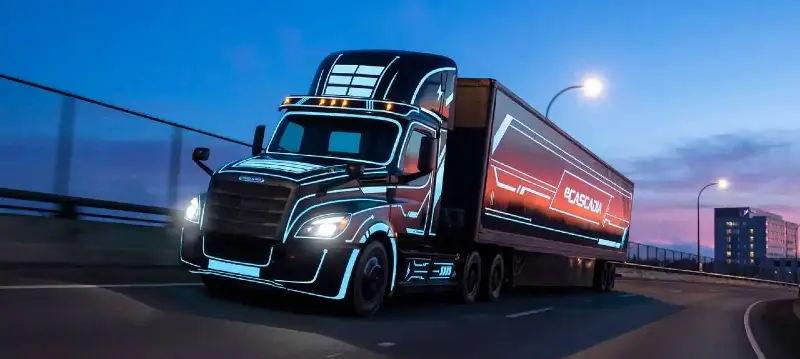
Freightliner has introduced the Cascadia, Volvo their VNR Electric, Kenworth their T680E model, BYD (China) their 8TT model, etc.
These are all impressive electric trucks, but reports* suggest that the Tesla Semi is simply in a league of its own and is setting the bar much higher in this category.
*In particular, we’d like to stress the performance comparison undertaken by Youtuber CleanerWatt.
The Tesla Semi
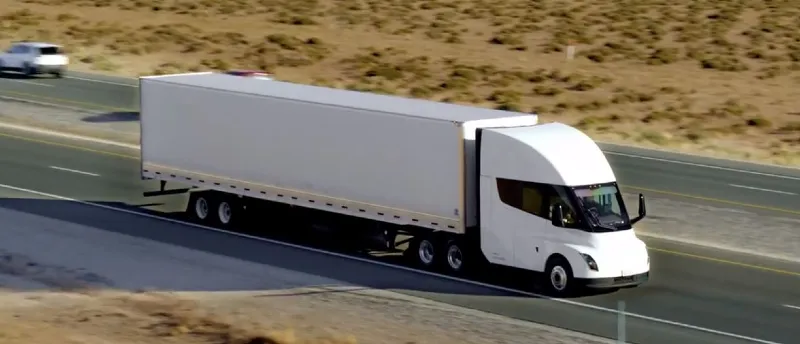
The Tesla Semi was unveiled in November 2017, and its initial roadmap indicated production could start as early as 2019.
But the Semi suffered multiple setbacks, including a supply chain crisis due to the global pandemic, so production only began in October 2022.
The first set of pre-ordered trucks was recently delivered on 1 December 2022 to Pepsi Co, and its performance was boasted during its unveiling, taking the electric truck industry by storm.
Range
Elon Musk recently tweeted that the Tesla Semi completed a 500-mile (800 km) journey between Freemont to San Diego fully loaded with 81,000 lbs (37 Tonnes) of goods and posted a time-lapse clip of the journey.
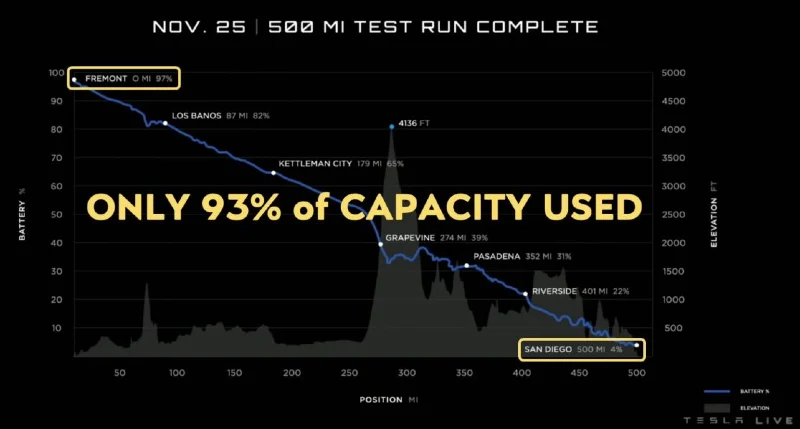
For context, the trip included crossing a 4000-foot pass near Grapevine, CA which makes it even more realistic. (Also, note in the chart above how the battery capacity goes up on the downhill due to regenerative braking.)
Research suggests that a 500-600 mile range is optimal because it’s the typical distance a truck can drive in a typical day without overcoming the U.S. federal limits on driving hours.
The only electric truck in this category to be able to achieve this ideal range is the Tesla Semi, with its current competitors achieving a fraction of this ideal laden range.
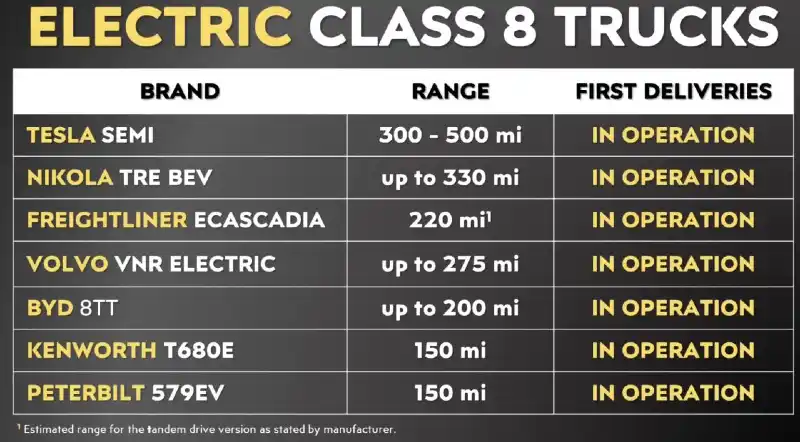
It’s worth considering that most of these figures are only estimates. Also, there are actually two versions of the Tesla Semi, one with a 300-mile range and the other with a 500-mile range, but we’re only covering the 500-mile version here.
Efficiency
Tesla has not yet revealed the exact specs of the Tesla Semi, so these are mainly educated guesses.
Elon Musk recently tweeted that the Tesla Semi has an efficiency of 1.7kWh per mile.
💡At current business electricity prices in the UK, this would make the Tesla Semi similarly cost-efficient to diesel lorries.
This translates to an estimated battery capacity of between 850 and 900 kWh, which is much larger than its competitors considering the Tesla Semi can carry the same payload.
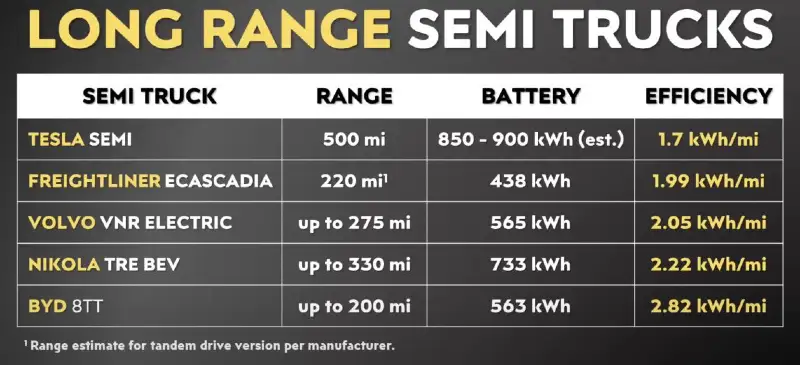
This engineer has speculated that this is roughly equivalent to 10 Tesla Model S batteries, which is consistent with claims that the Tesla Semi would be using inverters, drive units, power electronics, HVAC, and infotainment from other Tesla models.
Other factors influencing the outlandish efficiency may be associated with the design of the truck, which has multiple drive trains it can use according to its circumstance to optimise energy usage.
Estimates of the unladen weight of the truck are guessed as being between 25,000 and 27,000 pounds, and its power output is at 1,000 HP, which lets it accelerate in 6% inclines and reach 60mph in 20 seconds on flat roads.
Charging stations
One of the main challenges behind fleets of long-haul electric trucks also lies in having an adequate charging infrastructure to support it.
This network is currently non-existent, and companies like Pepsi that are receiving their first truck orders have to manage with an internal network of chargers that is adequate for its standardised routes.
This is an effective blocker for the rolling out of the Semis, as without fast charging drivers are required to stop for longer than is required.
This is particularly the case in the U.S., where many truckers work independently, and their livelihoods are at the mercy of their efficiency.
However, Tesla has proven to be more than capable of deploying extensive charging networks.
The number of Tesla Superchargers (capable of charging a typical Tesla EV in minutes) already spans over 40,000, making it the most extensive global network.

Trucks could technically use this pre-existing network to charge their gargantuan batteries (i.e. nearly 10 to 20 times larger than existing Tesla EVs) but it would take too long to compete with traditional diesel semi-trucks.
To remedy this, Tesla plans to deploy a large network of 1,000V Megachargers that would be able to charge the trucks to 70% within 30 minutes, significantly faster than its competitors.
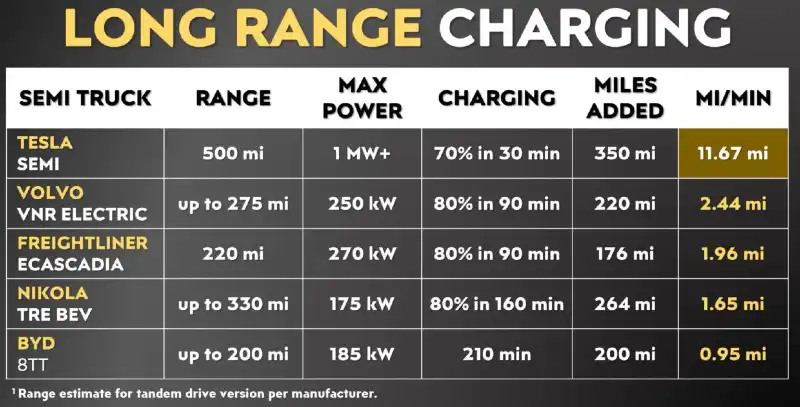
And the effect of this charging time on its performance is amplified when the Semi’s superior range is considered. The Semi is 5x more effective on a mile-per-minute charging basis, as estimated by the stellar CleanerWatt.
Cabin and driving experience
Since an electric Semi-truck doesn’t need a large petrol engine under the hood (i.e. the Tesla Semi’s drive train is the “size of a football”), there is significantly more space available at the front to enhance the experience of drivers.
Tesla has made the cabin large enough for the average person to stand up in and spacious enough for most tasks.
Also, the design is significantly different to that of its competitors, who have gone for a modernised version of mainstream cabins.
First orders
As of December 2022, the Tesla Semi is officially being delivered to its pre-ordered customers.
The first company to be receiving them is PepsiCo, and the Pepsi-Frito-Lay division of the company has already completed its first cargo run using the Tesla Semi.
Tesla is also planning to use the vehicle for its own freight needs, transporting goods between suppliers and factories.
A bright future despite challenges
The Tesla Semi is exciting and seems like the strongest candidate to rapidly replace existing combustion engine trucking fleets.
Not only because of its stellar performance compared to its competitors but also because of Elon Musk’s proven ability to deliver against all odds.
Let’s not forget that most ‘revolutionary’ technologies actually fail to succeed for multiple reasons despite obviously being useful products on paper.
The Semi is only at the start of its journey and it will take many years of stressors to be deemed a success, as well potential to keep innovating a space that has been lagging behind technology for decades.
Will it perform adequately in polar regions? Will there be financial blockers for the mass production of the units and deployment of the mega chargers? Will the units be allowed to compete in heavily controlled markets like China?
These are all pertinent questions for any nascent idea, but with Elon’s dogged determination and the financial firepower of Tesla, the odds are certainly in the Semi’s favour.

